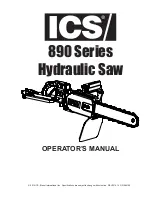
15
9. Place the lock washer and then the flat washer onto
the blade shaft screw and insert the screw into the
blade shaft through the center of the outer flange.
10. Tighten the screw by hand. Slowly lower the saw, if
necessary, until the blade just touches the ground.
11. Tighten the screw again, using the wrench, to 125 ft-
lb (170 Nm) minimum to secure the outer flange and
blade.
12. Remove the detent pin (guards 26” and up) from the
guard hinge and pivot the front of the guard down
over the blade to secure.
13. If replacing the front of the guard, fit the front and
back of the blade guard together. Place the screw
through the center of the guard hinge and tighten the
lock nut to the other end of the hinge screw to
secure the guard together.
Note: Have a second
trained operator hold the guard in place while
replacing the hinge screw and nut
.
Removing the Blade
CAUTION
DO NOT remove a blade with the
engine running.
DO NOT pivot the front of the blade guard up
or down when removing very large blades.
Attempting to pivot the front of a heavy guard
when the guard is positioned higher up for
blade removal makes the guard difficult to lift
and/or lower. In this situation, remove the
blade guard front instead of pivoting it.
Always secure the pivoted section of the blade
guard using the detent pin (guards 26” and
up).
1. Remove the detent pin (guards 26” and up) from the
guard hinge and pivot the front of the blade guard
180° (fully upward) to gain access to the blade. For
larger, heavier guards that are positioned too high
up and are unsafe to pivot, remove the lock nut and
screw from the center of the guard hinge. Remove
the front of the guard.
Note: Have a second trained
operator hold the guard in place while removing the
hinge screw and nut
.
2. On the pivoted guards, insert the detent pin through
the interlocking barrels on the top of the guard to
secure the front of the guard.
Note: Failure to fully
pivot and secure the front of the guard may cause
serious injuries
.
3. Slowly lower the saw, if necessary, until the blade
just touches the ground.
4. Remove the blade shaft screw using the wrench.
5. Carefully remove the outer flange and blade. Place
the blade in an appropriate storage location.
Note: If
the outer flange is difficult to remove, tighten a
setscrew into two of the holes on the outer flange to
help separate the outer flange from the blade
.
6. Inspect the flange assembly and clean or replace
dirty/damaged components.
7. Carefully fit the outer flange back into the inner
flange and/or blade shaft.
8. Place the lock washer and then the flat washer onto
the blade shaft screw and insert the screw into the
blade shaft through the center of the outer flange.
9. Retighten the blade shaft screw to secure the
flanges.
10. Remove the detent pin (guards 26” and up) from the
guard hinge and pivot the front of the guard down
over the blade flanges to secure.
11. If replacing the front of the guard, fit the front and
back of the blade guard together. Place the screw
through the center of the guard hinge and tighten the
lock nut to the other end of the hinge screw to
secure the guard together.
Note: Have a second
trained operator hold the guard in place while
replacing the hinge screw and nut
.
Engine
WARNING
Operate the saw in well-ventilated
areas. Concentrated engine exhaust
can cause loss of consciousness
and/or death.
DO NOT touch the engine/muffler with the
engine running, and always let them cool down
prior to touching or servicing the saw.
DO NOT leave the saw unattended while the
engine is running.
Figure 10: Vernier Throttle
Summary of Contents for CC7074
Page 1: ...Page 1 DIAMOND P R O D U C T S OPERATOR S MANUAL CONCRETE SAW MODEL CC7074 Manual 1801371...
Page 9: ......
Page 23: ......
Page 37: ......
Page 43: ...40 Notes...
Page 44: ...Issued 6 June 2011 Diamond Products Limited 2011...
















































